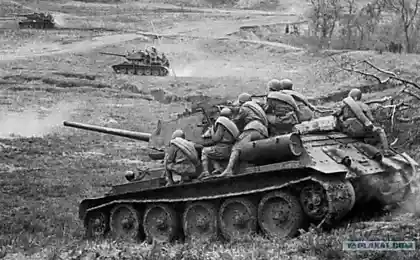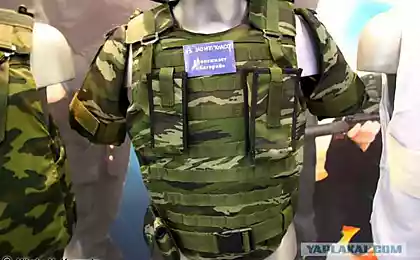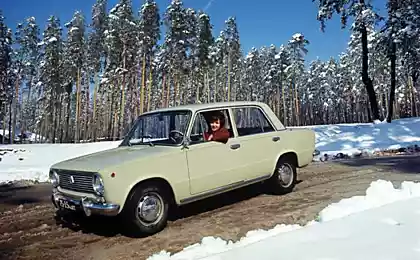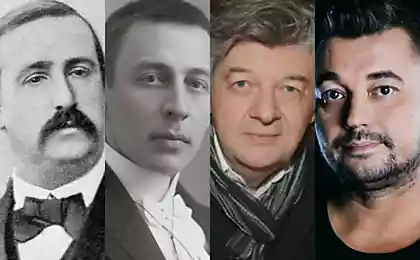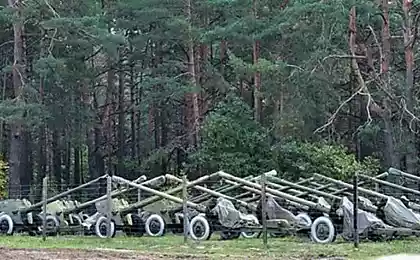2765
Domestic mortars in the postwar period
In the continuation of the:
British and American rocket artillery
German rocket artillery during the war
Today I want to tell you (who do not know / have not heard / not interested) about another form of weapons like mortars, no less they contributed to the victory over Nazi Germany and this artiilleriya. What, indeed, worthy of our attention to you.
The Soviet Union ended the war with a large park mortar weapons. In the Red Army were proven in combat battalion 82 mm and 120-mm mortars regiment.
Armed with heavy mortar brigades were part of the reserve artillery breakthrough divisions of the Supreme Command consisted of 160-mm mortars.
25 pictures, via.

In the early postwar years, the improvement of this highly effective weapon continued. First of all it touched 160 mm heavy mortars, intended for long-term defense of hacking.
In the summer of 1945 it was made the first modernization of the 160-mm mortar arr. 1943 In the new mortar, called MT-13D barrel length has been increased by 50 mm and the range of up to 7400 m.
In 1949, he entered into service in Kolomenskoye SKB developed under the leadership of GA BI Shavyrina new heavy 160-mm mortar M-160. Firing range of which reach 8040 m, and the construction was easier.
160-mm mortar sample 1949

The troops of 160-mm mortar Divisional sample 1949 (M-160) began to arrive in 1953. Until 1957, it was produced in 2353 mortar.
Mortars of this type for a long time were in service at the moment several hundred mortars M-160 are in Russia for storage bases.
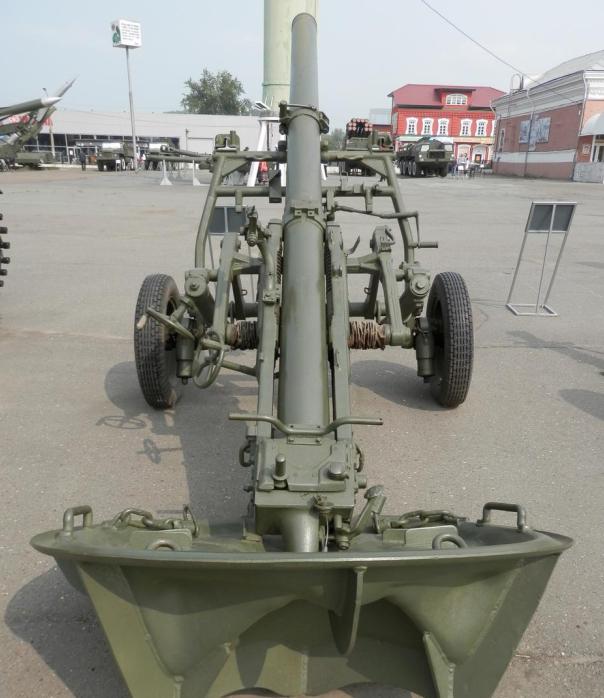
In 1950, he adopted after lengthy trials enrolled developed BI Shavyrin even more heavy, still has no analogues in the world 240-mm breech-loading mortar. This "monster" was leading the fire high-explosive mine F-864 weight 130, 7 kg, at a distance of up to 9650 meters.
Loading the 240-mm mortar arr. 1950
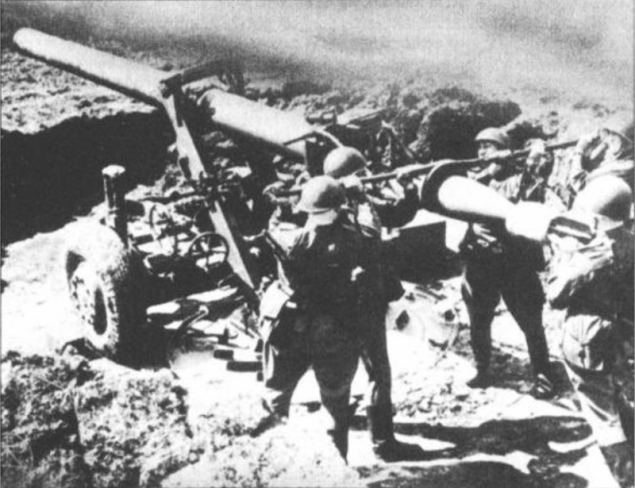
Almost similar artillery unit 2B8 used 240-mm self-propelled mortar - 2S4 "Tulip", which was adopted in 1971. It was created to replace the towed 240-mm mortar M-240 mod. 1950 and surpassed the M-240 on the battlefield survivability and combat effectiveness by improving maneuverability, patency, reducing the time characteristics for opening fire and withdrawal from the firing position.
Self-propelled 240-mm mortar 2S4 «Tulip» stowed
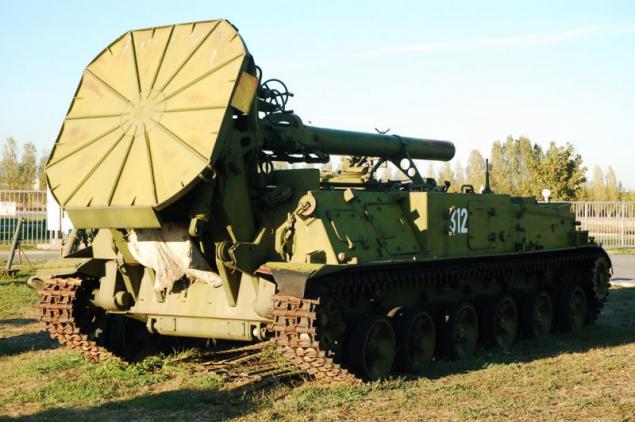
Self-propelled 240-mm mortar has a high maneuverability and effectiveness minutes from goal, ability to overcome infested terrain, high maneuverability.
For firing the mortar does not require special preparation before firing position. Angle charging 2B8 is about + 63 °. Mines loading rod for guiding fed automatically from a mechanical boeukladki arranged in the housing chassis (two combat pack 40 located explosive or 20 active-reactive min). Moreover, loading can be performed from the ground using a crane. Horizontal pointing left hand. Mounted on 2S4 diesel V-59 allows you to develop a highway speed of 60 km / h, and on dirt roads - 30 km / h.
In the postwar period, no country in the world to accept service of such powerful mortars. Self-propelled mortar 2S4 is the only in the world of this caliber and mortar counterparts do not have.
Self-propelled 240-mm mortar 2S4 «Tulip" in firing position
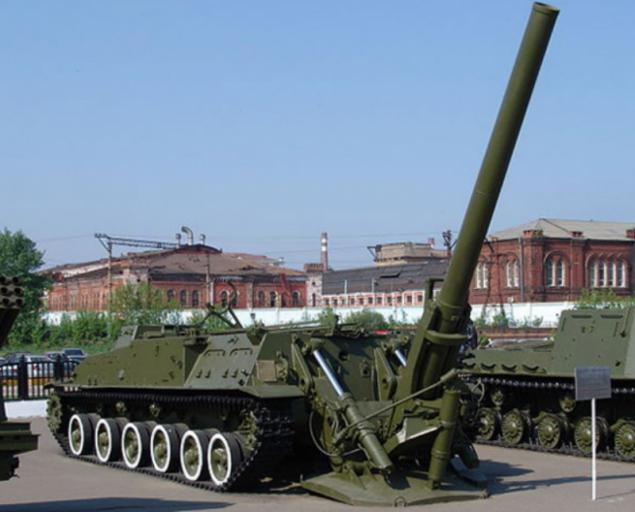
In 1955 it has been adopted 120-mm mortar designed and led BI Shavyrina. 120 mm regimental mortar sample in 1955 (M-120) was established based on the experience of combat employment of 120 mm regimental mortar arr. 1943.
120 mm regimental mortar arr. 1955
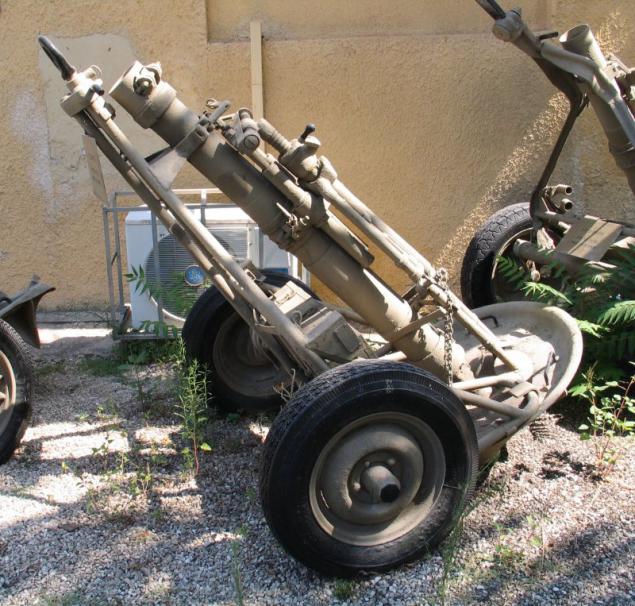
At the same weight as that of the 120-mm regimental mortar arr. 1943., The new mortar had a large range, and reached 7100 meters. Median lateral deviation when shooting is 12, 8 meters, and the mean deviation in range - 28, 4 meters.
Time to bring in a mortar firing position was reduced to 1, 5 min. 120-mm mortar arr. 1955 was in service in parallel with the 120-mm mortars other models.
120-mm mortar shells
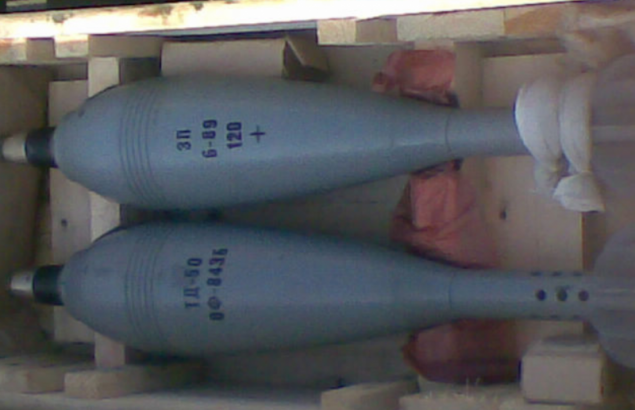
In 70 years on the basis of a light armored towing vehicle MT-LB was created propelled mortar "Tundzha».
This self-propelled mortar for the armies of the Warsaw Pact produced in Bulgaria. Total built about 400 such machines.

At the end of 1960. 120 mm mortars in the Soviet army were transferred from the regimental level in the battalion. This significantly increases the firepower the battalions, but at the same time demanded that the 120-mm mortar greater mobility. However, since the mid 50's after coming to power of Khrushchev in the Soviet Union there was overreliance missiles.
In fact, a ban was placed on the development of new types of artillery and mortar weapons. All the mortars were declared "obsolete", and 82-mm mortars as "insufficiently effective" were removed from the parts. Soviet military leadership took some time to understand the fallacy of this decision, it is largely influenced by the experience of the effective application of mortars in numerous local conflicts since the mid '60s the surviving artillery KB reoccupied the design of new models.
The CRI "Petrel" was developed lightweight 120-mm mortar complex "Sani", put into service in 1979, under the symbol 2S12. The complex includes a mortar 2B11, detachable wheel stroke 2L81 and transport vehicles 2F510 based on GAZ-66-05.
Mortar 2B11

Weight mortar in the stowed position - 300 kg in firing position - 210 kg. The weight of the barrel mortar 2B11 - 74 kg, the bipod-mast - 55 kg, the base plate 82 kg. Rate: 15vystr. / Min. Sighting range from 480 to 7100 meters. Sighting range guided munitions KM 8 "Edge": 9000 meters.
Sights mortar consist of optical mortar sight MPM-44M, gun collimator K-1 and lighting device RAY-PM2M. Sight provides two 55-fold increase in its field of view is equal to 9 °. The collimator allows shooting in poor visibility conditions. At night, the lighting grid, scale and levels aiming sight and collimator illumination device made BEAM-PM2M, which also has a lighting system jobs commander and equip.
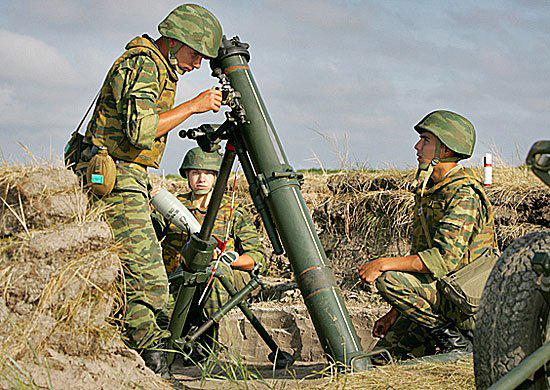
The basic version of the mortar transporting - transported in the back of the transport car 2F510. The transport vehicle is designed on the basis of the on-board an army truck GAZ-66-05 (4x4) and is designed to transport mortar calculation, ammunition and spare parts kit. Loading and unloading of the mortar in the back of the machine to make calculations manually via reclined tailgate for an extended body of the two ramps.
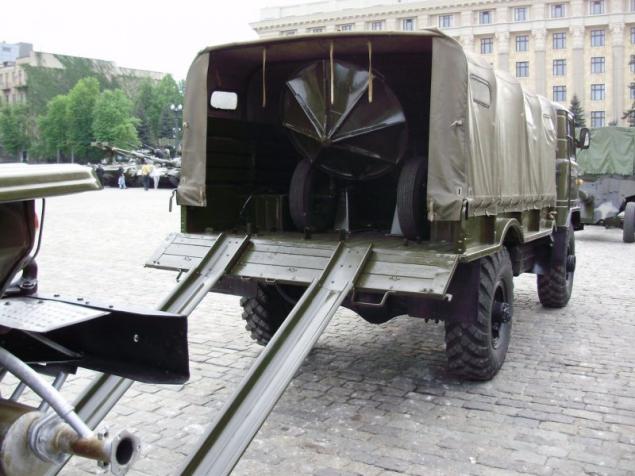
Upgraded Version 2S12A got a new car-towing. Now it's a truck "Ural-43206" or tractor MT-LB. Transportation mortar with the wheel stroke can be either a simple towing or in a truck or on the roof of a tracked vehicle.
For loading transport vehicles are equipped with a quick ramp and winch tray design.
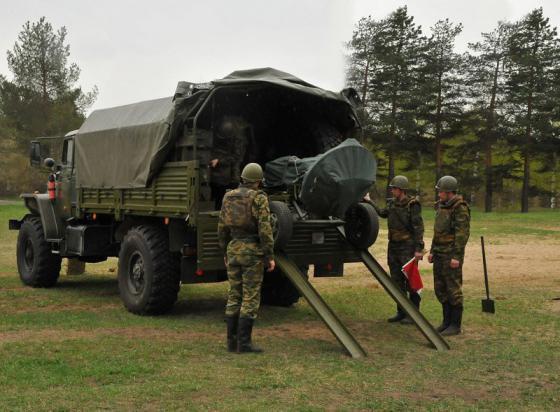
The updated structure of complex equipment provides faster set Diverting from marching into the firing state, and vice versa, including reduced strength calculation.

In some countries, using 2B11 were created self-propelled mortars. Bulgaria has produced a self-propelled mortar "Tundzha-sled" on the basis of the MT-LB.
At the moment, there is a tendency of the actual merger of 120-mm rifled breech-loading mortars and howitzers. New universal tools have the ability to fire both rifled shells and feathered mortar mines.
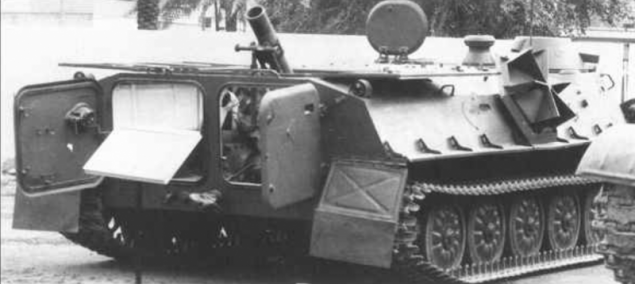
The first such domestic system became established in 1976 at the Perm engineering plant 120mm division-regimental airborne self-propelled guns - 2S9 "Nona-S».
SAO 2S9 "Nona-S" is intended to suppress manpower, artillery and mortar batteries, rocket launchers, armored targets, weapon systems and command and control.
Airborne self-propelled guns - 2S9 "Nona-S»

SAO 2S9 main armament is a 120mm rifled gun-howitzer, mortar 2A51. Shooting from guns is carried out as a high-performance 120-mm rifled shells and 120-mm mortar mines of various types.
"Nona-S" was adopted by the self-propelled artillery battalion parachute regiment in 1980 and passed "baptism of fire" in Afghanistan, which has proved itself very well.
Later, in addition to Airborne for other arms, it was developed and adopted for service several CAO of this type. On the arms artillery battalions of mechanized infantry brigade units of the Land Forces and Naval Infantry Brigade to replace the 120-mm towed mortar complexes 2S12 "Sani" enters self-propelled guns on armored personnel carriers BTR-shasii 80 - 2S23 "Nona-SVK».
2S23 self-propelled gun "Nona-SVK»
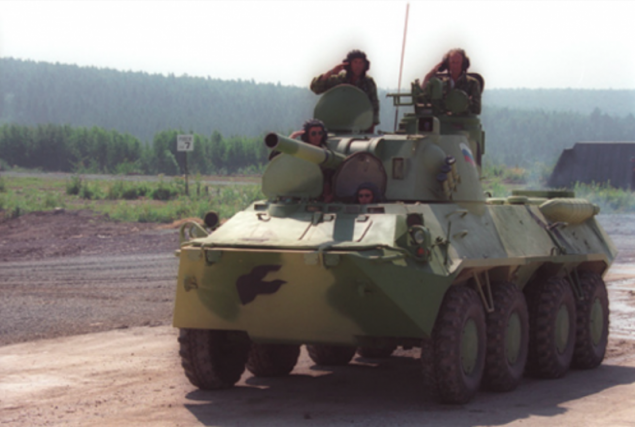
On the chassis of the BMP-3 in 1995 established 120 mm CAO - 2S31 "Vienna", with a range of up to 14,000 meters. Designed for armament artillery battalions of mechanized infantry or armored units.
The modernization SAO 2S1 "Carnation" similar to 120-mm gun, a mortar was installed in place of 122 mm gun 2A31.
Deep upgraded with new weapons CAO received oboznachenie- 2S34 "Hosta". "Host" is intended to suppress manpower, artillery and mortar batteries, rocket launchers, armored targets, weapon systems and command and control at a distance of 13 km.
2S34 self-propelled gun "Hosta»
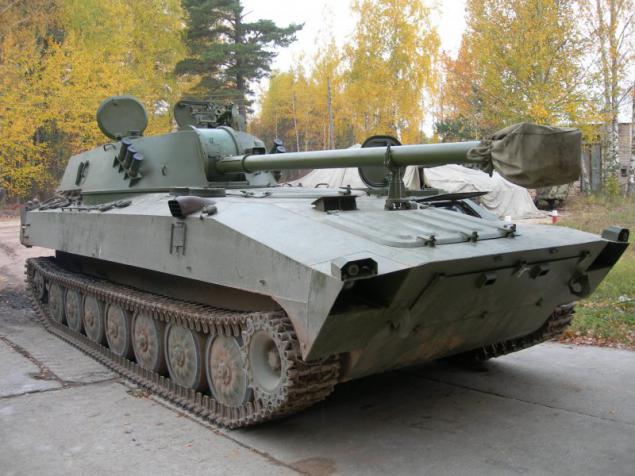
In addition to self-propelled, developed and taken into service towed: 2B16 "Nona-K" and 2B23 "Nona-M1."
2B16 "Nona-K" is a towed variant guns mounted on self-propelled artillery gun 2S9 "Nona-S", and retains all of the qualities and characteristics of the underlying instrument.
Designed for artillery battalions air assault brigades. It is designed based on the experience of fighting ground troops of the Soviet army in Afghanistan. In 1986, the gun was taken into service.
Towed 120-mm gun-mortar 2B16 "Nona-K»
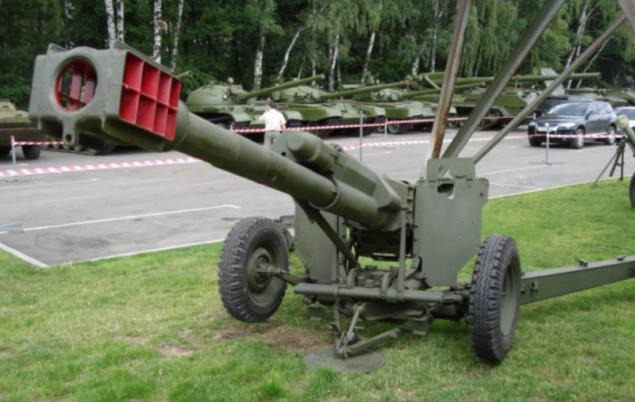
In 2007, the Russian Army received 120-mm mortar 2B23 "Nona-M1." Its main purpose is to destroy the enemy's manpower, defeat light armored and soft-skinned vehicles.
2B23 mortars mortar battery must be equipped with a motorized infantry battalion of ground troops. Also 2B23 mortars can be armed paratroops VDV as 2B23 has the possibility of landing on special platforms.
Mortar 2B23 can use all types of mines caliber 120 mm, moreover, in the range of munitions used included the bulk of the shots with ready rifling guns for the family, "Nona».
Issued in the USSR 120mm mortars were used in a variety of local conflicts, which invariably demonstrated its high efficiency.
Mortar 2B23 "Nona-M1»
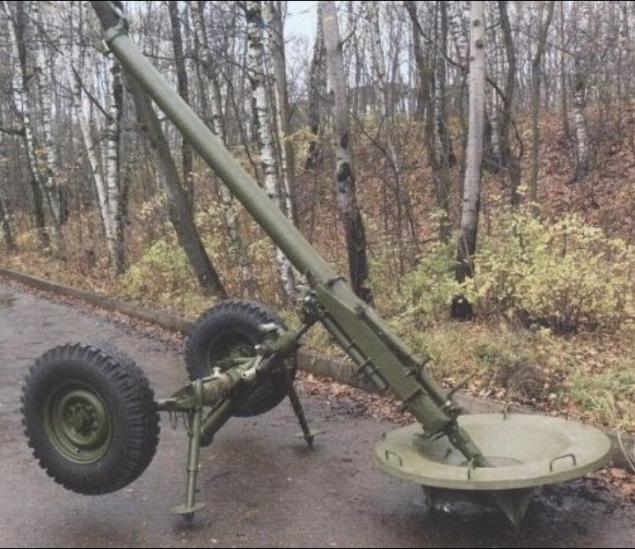
In 1970 has been adopted automatic caliber mortar 82 mm - 2B9 "Cornflower", a practical rate of 100-120 rds / min. Theoretically, it can replace 5-6 82 mm mortars with a manual loader.
The loading in mortar 2B9 "Cornflower" a cassette in the tape placed four mines. Mortar allows for two modes of fire - single and automatic trunk smooth. The design of the mortar was made under the scheme, which is used when creating a breech-loading artillery. Such a scheme will fully automate the loading of the mortar. The opening of the gate, the supply to the line loading, chambering the bolt in the mines, closing speed and shot are carried out automatically. Loading mechanism is driven by the energy of powder gases. The resulting shot recoil energy is used for actuation by means of return springs, automatic loading mechanism.
For firing the mortar has developed new high-performance 82-mm mines. Maximum range of fire 4,250 meters, minimum 800 meters, weight mines 832DU O-3, 1 kg. With the explosion of mines produced no less than 400 fragments, the radius of the continuous destruction of at least 6 meters in radius effective at. For firing at armored targets has been developed cumulative mine.
Mortar 2B9 "Cornflower»
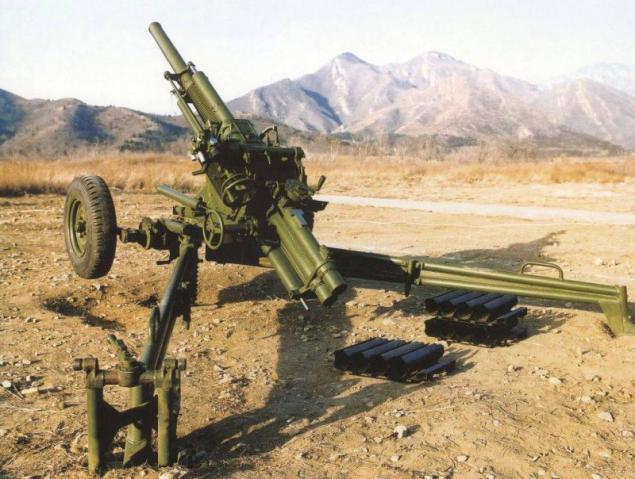
When the mass of 632 kg mortar 2B9, can be moved by the calculation without the use of a vehicle. On long-distance moves mortar or in the back or towing, using transport machine 2F54 (specially created on the basis of GAZ-66), with which it is designated as a system 2K21. The body 2F54, rolled into the mortar using special ramps. However, in the 80 years for transportation of mortars started to use tracked tractor MT-LB, which he placed on a platform at the rear of the housing.
Upgraded version of the mortar, designated 2B9M "cornflower", differed from its predecessor the air cooling system of the barrel and the presence of cooling fins located on the central portion thereof. Upgraded mortar was put into production, and adopted by the Army in 1983.
Mortar was used extensively during the fighting in Afghanistan and in Chechnya, in the course of "counter-terrorist operation»

In 1983 it has been adopted 82-mm mortar 2B14 "Tray". Mortar 2B14 created by the scheme imaginary triangle. Barrel mortar - smooth tubes with navintnym breech. Optical sight MPM-44M.
82 mm mortar 2B14 "Tray»

Punching base plate round shape with welded bottom lugs. In the stowed position mortar disassembled and transported or carried in his pack of three. Weight packs stowed: pack trunk - 16, 2 kg pack base plate - 17 kg pack bipod - 13, 9 kg. Rate without correcting crosstalk to 20 rds / min. Firing range from 85 to 3920 meters.
Modernization Project "Tray" is called 2B24 and is a further development of the project 2B14. Construction 2B24 mainly differs from its predecessor in a barrel. This innovation has greatly increased the maximum range, now it is almost six kilometers. In order to ensure an acceptable temperature of the trunk and avoid deformation in the breech has radiator fins. 2B24 mortar can fire all available 82 mm caliber mine. In addition, during its development it was created high-explosive mine high power 3-O-26.
Without any changes to the design of a mortar 2B24 can be converted to self-propelled worn out. To do this using a special mounting kit is installed in the mortar troop compartment armored tractor MT-LB. This complex was named 2K32 "Virgin". It is noteworthy that 2F510-2 mounting kit allows you to quickly remove it from the mortar and use portable version. Ammunition combat vehicle 2K32 is 84 mines.
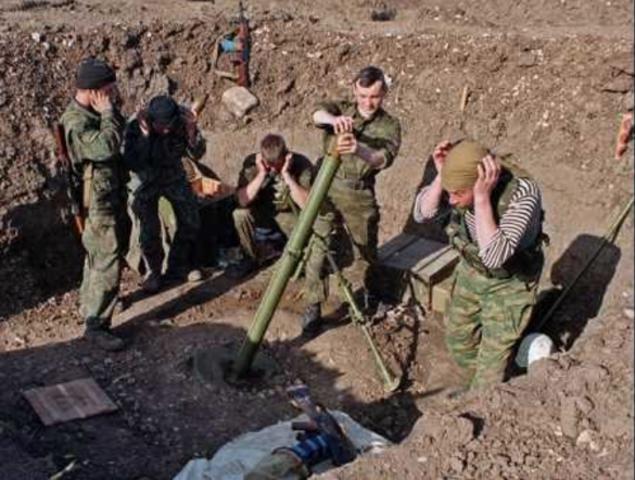
The exhibition MILEX-2011 in Minsk was presented developed at the Central Research Institute "Petrel" 82-millimeter mortar 2B25 wearable "Gull". A distinctive feature of 2B25 is the lack of standard features shot in the conduct of fire and small weight and dimensions. Weighing 13 kg, the mortar is able to conduct effective fire at a range of 100 to 1200 meters. Rate - 15 rds / min.
"Quiet" shots of mortar is achieved through the use of a specially designed fragmentation shot 3VO35E. When fired, the shank mines locks powder gases in the barrel of the mortar, so that does not create noise, flames, smoke, and the shock wave. Volume shot 2B25 comparable with a shot from AKM with a silencer.
These characteristics provide a mortar high mobility and enable stealth and sudden application
82 mm mortar 2B25 "Gall»

At the moment, the armament in Russia mortars superior or inferior to a foreign model. At the same time, lagging behind in terms of creation of highly controlled mortar rounds.
Everything started in our country, this type of munitions have a semi-active laser seeker, which implies illumination purpose. Under the conditions of full-scale hostilities, with a high smoke and dusty battlefield, such a possibility can not be. At the same time abroad are actively homing mines with infrared or radar seeker and corrected with the guidance, on signals received from the satellite navigation system. ©
I that's all, thank you for your attention and enjoy reading !!!
P.S. Last photo simply by itself dobavil.Kto knows is 2S5 "Hyacinth C»
P.P.S.
British and American rocket artillery
German rocket artillery during the war
Today I want to tell you (who do not know / have not heard / not interested) about another form of weapons like mortars, no less they contributed to the victory over Nazi Germany and this artiilleriya. What, indeed, worthy of our attention to you.
The Soviet Union ended the war with a large park mortar weapons. In the Red Army were proven in combat battalion 82 mm and 120-mm mortars regiment.
Armed with heavy mortar brigades were part of the reserve artillery breakthrough divisions of the Supreme Command consisted of 160-mm mortars.
25 pictures, via.

In the early postwar years, the improvement of this highly effective weapon continued. First of all it touched 160 mm heavy mortars, intended for long-term defense of hacking.
In the summer of 1945 it was made the first modernization of the 160-mm mortar arr. 1943 In the new mortar, called MT-13D barrel length has been increased by 50 mm and the range of up to 7400 m.
In 1949, he entered into service in Kolomenskoye SKB developed under the leadership of GA BI Shavyrina new heavy 160-mm mortar M-160. Firing range of which reach 8040 m, and the construction was easier.
160-mm mortar sample 1949

The troops of 160-mm mortar Divisional sample 1949 (M-160) began to arrive in 1953. Until 1957, it was produced in 2353 mortar.
Mortars of this type for a long time were in service at the moment several hundred mortars M-160 are in Russia for storage bases.

In 1950, he adopted after lengthy trials enrolled developed BI Shavyrin even more heavy, still has no analogues in the world 240-mm breech-loading mortar. This "monster" was leading the fire high-explosive mine F-864 weight 130, 7 kg, at a distance of up to 9650 meters.
Loading the 240-mm mortar arr. 1950

Almost similar artillery unit 2B8 used 240-mm self-propelled mortar - 2S4 "Tulip", which was adopted in 1971. It was created to replace the towed 240-mm mortar M-240 mod. 1950 and surpassed the M-240 on the battlefield survivability and combat effectiveness by improving maneuverability, patency, reducing the time characteristics for opening fire and withdrawal from the firing position.
Self-propelled 240-mm mortar 2S4 «Tulip» stowed

Self-propelled 240-mm mortar has a high maneuverability and effectiveness minutes from goal, ability to overcome infested terrain, high maneuverability.
For firing the mortar does not require special preparation before firing position. Angle charging 2B8 is about + 63 °. Mines loading rod for guiding fed automatically from a mechanical boeukladki arranged in the housing chassis (two combat pack 40 located explosive or 20 active-reactive min). Moreover, loading can be performed from the ground using a crane. Horizontal pointing left hand. Mounted on 2S4 diesel V-59 allows you to develop a highway speed of 60 km / h, and on dirt roads - 30 km / h.
In the postwar period, no country in the world to accept service of such powerful mortars. Self-propelled mortar 2S4 is the only in the world of this caliber and mortar counterparts do not have.
Self-propelled 240-mm mortar 2S4 «Tulip" in firing position

In 1955 it has been adopted 120-mm mortar designed and led BI Shavyrina. 120 mm regimental mortar sample in 1955 (M-120) was established based on the experience of combat employment of 120 mm regimental mortar arr. 1943.
120 mm regimental mortar arr. 1955

At the same weight as that of the 120-mm regimental mortar arr. 1943., The new mortar had a large range, and reached 7100 meters. Median lateral deviation when shooting is 12, 8 meters, and the mean deviation in range - 28, 4 meters.
Time to bring in a mortar firing position was reduced to 1, 5 min. 120-mm mortar arr. 1955 was in service in parallel with the 120-mm mortars other models.
120-mm mortar shells

In 70 years on the basis of a light armored towing vehicle MT-LB was created propelled mortar "Tundzha».
This self-propelled mortar for the armies of the Warsaw Pact produced in Bulgaria. Total built about 400 such machines.

At the end of 1960. 120 mm mortars in the Soviet army were transferred from the regimental level in the battalion. This significantly increases the firepower the battalions, but at the same time demanded that the 120-mm mortar greater mobility. However, since the mid 50's after coming to power of Khrushchev in the Soviet Union there was overreliance missiles.
In fact, a ban was placed on the development of new types of artillery and mortar weapons. All the mortars were declared "obsolete", and 82-mm mortars as "insufficiently effective" were removed from the parts. Soviet military leadership took some time to understand the fallacy of this decision, it is largely influenced by the experience of the effective application of mortars in numerous local conflicts since the mid '60s the surviving artillery KB reoccupied the design of new models.
The CRI "Petrel" was developed lightweight 120-mm mortar complex "Sani", put into service in 1979, under the symbol 2S12. The complex includes a mortar 2B11, detachable wheel stroke 2L81 and transport vehicles 2F510 based on GAZ-66-05.
Mortar 2B11

Weight mortar in the stowed position - 300 kg in firing position - 210 kg. The weight of the barrel mortar 2B11 - 74 kg, the bipod-mast - 55 kg, the base plate 82 kg. Rate: 15vystr. / Min. Sighting range from 480 to 7100 meters. Sighting range guided munitions KM 8 "Edge": 9000 meters.
Sights mortar consist of optical mortar sight MPM-44M, gun collimator K-1 and lighting device RAY-PM2M. Sight provides two 55-fold increase in its field of view is equal to 9 °. The collimator allows shooting in poor visibility conditions. At night, the lighting grid, scale and levels aiming sight and collimator illumination device made BEAM-PM2M, which also has a lighting system jobs commander and equip.

The basic version of the mortar transporting - transported in the back of the transport car 2F510. The transport vehicle is designed on the basis of the on-board an army truck GAZ-66-05 (4x4) and is designed to transport mortar calculation, ammunition and spare parts kit. Loading and unloading of the mortar in the back of the machine to make calculations manually via reclined tailgate for an extended body of the two ramps.

Upgraded Version 2S12A got a new car-towing. Now it's a truck "Ural-43206" or tractor MT-LB. Transportation mortar with the wheel stroke can be either a simple towing or in a truck or on the roof of a tracked vehicle.
For loading transport vehicles are equipped with a quick ramp and winch tray design.

The updated structure of complex equipment provides faster set Diverting from marching into the firing state, and vice versa, including reduced strength calculation.

In some countries, using 2B11 were created self-propelled mortars. Bulgaria has produced a self-propelled mortar "Tundzha-sled" on the basis of the MT-LB.
At the moment, there is a tendency of the actual merger of 120-mm rifled breech-loading mortars and howitzers. New universal tools have the ability to fire both rifled shells and feathered mortar mines.

The first such domestic system became established in 1976 at the Perm engineering plant 120mm division-regimental airborne self-propelled guns - 2S9 "Nona-S».
SAO 2S9 "Nona-S" is intended to suppress manpower, artillery and mortar batteries, rocket launchers, armored targets, weapon systems and command and control.
Airborne self-propelled guns - 2S9 "Nona-S»

SAO 2S9 main armament is a 120mm rifled gun-howitzer, mortar 2A51. Shooting from guns is carried out as a high-performance 120-mm rifled shells and 120-mm mortar mines of various types.
"Nona-S" was adopted by the self-propelled artillery battalion parachute regiment in 1980 and passed "baptism of fire" in Afghanistan, which has proved itself very well.
Later, in addition to Airborne for other arms, it was developed and adopted for service several CAO of this type. On the arms artillery battalions of mechanized infantry brigade units of the Land Forces and Naval Infantry Brigade to replace the 120-mm towed mortar complexes 2S12 "Sani" enters self-propelled guns on armored personnel carriers BTR-shasii 80 - 2S23 "Nona-SVK».
2S23 self-propelled gun "Nona-SVK»

On the chassis of the BMP-3 in 1995 established 120 mm CAO - 2S31 "Vienna", with a range of up to 14,000 meters. Designed for armament artillery battalions of mechanized infantry or armored units.
The modernization SAO 2S1 "Carnation" similar to 120-mm gun, a mortar was installed in place of 122 mm gun 2A31.
Deep upgraded with new weapons CAO received oboznachenie- 2S34 "Hosta". "Host" is intended to suppress manpower, artillery and mortar batteries, rocket launchers, armored targets, weapon systems and command and control at a distance of 13 km.
2S34 self-propelled gun "Hosta»

In addition to self-propelled, developed and taken into service towed: 2B16 "Nona-K" and 2B23 "Nona-M1."
2B16 "Nona-K" is a towed variant guns mounted on self-propelled artillery gun 2S9 "Nona-S", and retains all of the qualities and characteristics of the underlying instrument.
Designed for artillery battalions air assault brigades. It is designed based on the experience of fighting ground troops of the Soviet army in Afghanistan. In 1986, the gun was taken into service.
Towed 120-mm gun-mortar 2B16 "Nona-K»

In 2007, the Russian Army received 120-mm mortar 2B23 "Nona-M1." Its main purpose is to destroy the enemy's manpower, defeat light armored and soft-skinned vehicles.
2B23 mortars mortar battery must be equipped with a motorized infantry battalion of ground troops. Also 2B23 mortars can be armed paratroops VDV as 2B23 has the possibility of landing on special platforms.
Mortar 2B23 can use all types of mines caliber 120 mm, moreover, in the range of munitions used included the bulk of the shots with ready rifling guns for the family, "Nona».
Issued in the USSR 120mm mortars were used in a variety of local conflicts, which invariably demonstrated its high efficiency.
Mortar 2B23 "Nona-M1»

In 1970 has been adopted automatic caliber mortar 82 mm - 2B9 "Cornflower", a practical rate of 100-120 rds / min. Theoretically, it can replace 5-6 82 mm mortars with a manual loader.
The loading in mortar 2B9 "Cornflower" a cassette in the tape placed four mines. Mortar allows for two modes of fire - single and automatic trunk smooth. The design of the mortar was made under the scheme, which is used when creating a breech-loading artillery. Such a scheme will fully automate the loading of the mortar. The opening of the gate, the supply to the line loading, chambering the bolt in the mines, closing speed and shot are carried out automatically. Loading mechanism is driven by the energy of powder gases. The resulting shot recoil energy is used for actuation by means of return springs, automatic loading mechanism.
For firing the mortar has developed new high-performance 82-mm mines. Maximum range of fire 4,250 meters, minimum 800 meters, weight mines 832DU O-3, 1 kg. With the explosion of mines produced no less than 400 fragments, the radius of the continuous destruction of at least 6 meters in radius effective at. For firing at armored targets has been developed cumulative mine.
Mortar 2B9 "Cornflower»

When the mass of 632 kg mortar 2B9, can be moved by the calculation without the use of a vehicle. On long-distance moves mortar or in the back or towing, using transport machine 2F54 (specially created on the basis of GAZ-66), with which it is designated as a system 2K21. The body 2F54, rolled into the mortar using special ramps. However, in the 80 years for transportation of mortars started to use tracked tractor MT-LB, which he placed on a platform at the rear of the housing.
Upgraded version of the mortar, designated 2B9M "cornflower", differed from its predecessor the air cooling system of the barrel and the presence of cooling fins located on the central portion thereof. Upgraded mortar was put into production, and adopted by the Army in 1983.
Mortar was used extensively during the fighting in Afghanistan and in Chechnya, in the course of "counter-terrorist operation»

In 1983 it has been adopted 82-mm mortar 2B14 "Tray". Mortar 2B14 created by the scheme imaginary triangle. Barrel mortar - smooth tubes with navintnym breech. Optical sight MPM-44M.
82 mm mortar 2B14 "Tray»

Punching base plate round shape with welded bottom lugs. In the stowed position mortar disassembled and transported or carried in his pack of three. Weight packs stowed: pack trunk - 16, 2 kg pack base plate - 17 kg pack bipod - 13, 9 kg. Rate without correcting crosstalk to 20 rds / min. Firing range from 85 to 3920 meters.
Modernization Project "Tray" is called 2B24 and is a further development of the project 2B14. Construction 2B24 mainly differs from its predecessor in a barrel. This innovation has greatly increased the maximum range, now it is almost six kilometers. In order to ensure an acceptable temperature of the trunk and avoid deformation in the breech has radiator fins. 2B24 mortar can fire all available 82 mm caliber mine. In addition, during its development it was created high-explosive mine high power 3-O-26.
Without any changes to the design of a mortar 2B24 can be converted to self-propelled worn out. To do this using a special mounting kit is installed in the mortar troop compartment armored tractor MT-LB. This complex was named 2K32 "Virgin". It is noteworthy that 2F510-2 mounting kit allows you to quickly remove it from the mortar and use portable version. Ammunition combat vehicle 2K32 is 84 mines.

The exhibition MILEX-2011 in Minsk was presented developed at the Central Research Institute "Petrel" 82-millimeter mortar 2B25 wearable "Gull". A distinctive feature of 2B25 is the lack of standard features shot in the conduct of fire and small weight and dimensions. Weighing 13 kg, the mortar is able to conduct effective fire at a range of 100 to 1200 meters. Rate - 15 rds / min.
"Quiet" shots of mortar is achieved through the use of a specially designed fragmentation shot 3VO35E. When fired, the shank mines locks powder gases in the barrel of the mortar, so that does not create noise, flames, smoke, and the shock wave. Volume shot 2B25 comparable with a shot from AKM with a silencer.
These characteristics provide a mortar high mobility and enable stealth and sudden application
82 mm mortar 2B25 "Gall»

At the moment, the armament in Russia mortars superior or inferior to a foreign model. At the same time, lagging behind in terms of creation of highly controlled mortar rounds.
Everything started in our country, this type of munitions have a semi-active laser seeker, which implies illumination purpose. Under the conditions of full-scale hostilities, with a high smoke and dusty battlefield, such a possibility can not be. At the same time abroad are actively homing mines with infrared or radar seeker and corrected with the guidance, on signals received from the satellite navigation system. ©
I that's all, thank you for your attention and enjoy reading !!!
P.S. Last photo simply by itself dobavil.Kto knows is 2S5 "Hyacinth C»
P.P.S.







